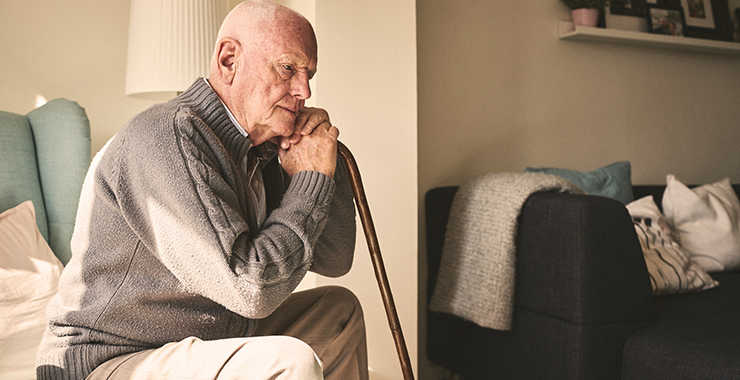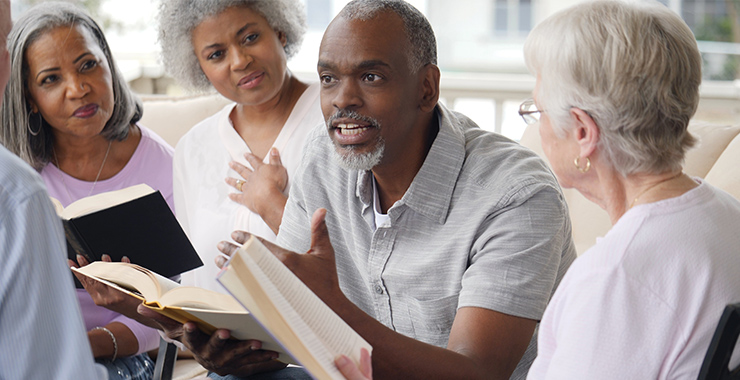what happen to you if you are lonely
Overview
CE credits: 1
Learning objectives: After reading this article, CE candidates will exist able to:
- Place the effects of social isolation and loneliness on concrete, mental and cognitive health.
- Explore how loneliness differs from social isolation.
- Discuss show-based interventions for combating loneliness.
For more information on earning CE credit for this article, go to world wide web.apa.org/ed/ce/resources/ce-corner.
According to a 2018 national survey by Cigna, loneliness levels have reached an all-fourth dimension high, with almost one-half of 20,000 U.S. adults reporting they sometimes or ever feel alone. Forty percent of survey participants likewise reported they sometimes or ever feel that their relationships are not meaningful and that they feel isolated.
Such numbers are alarming because of the wellness and mental health risks associated with loneliness. According to a meta-assay co-authored past Julianne Holt-Lunstad, PhD, a professor of psychology and neuroscience at Brigham Young University, lack of social connection heightens health risks as much every bit smoking 15 cigarettes a day or having booze use disorder. She's also establish that loneliness and social isolation are twice as harmful to physical and mental wellness as obesity ( Perspectives on Psychological Science , Vol. ten, No. ii, 2015 ).
"There is robust show that social isolation and loneliness significantly increase risk for premature bloodshed, and the magnitude of the risk exceeds that of many leading wellness indicators," HoltLunstad says.
In an effort to stem such health risks, campaigns and coalitions to reduce social isolation and loneliness—an individual'south perceived level of social isolation—have been launched in Australia, Denmark and the United Kingdom. These national programs bring together inquiry experts, nonprofit and government agencies, community groups and skilled volunteers to heighten awareness of loneliness and address social isolation through evidence-based interventions and advocacy.
But is loneliness really increasing, or is it a condition that humans accept always experienced at various times of life? In other words, are we becoming lonelier or just more inclined to recognize and talk near the problem?
These are tough questions to answer considering historical data well-nigh loneliness are scant. However, some research suggests that social isolation is increasing, so loneliness may be, too, says Holt-Lunstad. The most contempo U.S. census data, for example, prove that more than a quarter of the population lives alone—the highest rate e'er recorded. In addition, more than half of the population is single, and marriage rates and the number of children per household have declined since the previous census. Rates of volunteerism take too decreased, according to research past the University of Maryland's Do Skillful Found, and an increasing percentage of Americans study no religious affiliation—suggesting declines in the kinds of religious and other institutional connections that can provide community.
"Regardless of whether loneliness is increasing or remaining stable, we have lots of evidence that a significant portion of the population is affected past information technology," says HoltLunstad. "Being connected to others socially is widely considered a fundamental human demand—crucial to both well-being and survival."
As experts in behavior change, psychologists are well-positioned to help the nation gainsay loneliness. Through their research and public policy work, many psychologists have been providing data and detailed recommendations for advancing social connectedness equally a U.S. public wellness priority on both the societal and individual levels.
"With an increasing aging population, the effects of loneliness on public health are just anticipated to increase," Holt-Lunstad says. "The challenge we face now is figuring out what can exist washed about it."
Who is most likely?
Loneliness is an experience that has been around since the kickoff of fourth dimension—and we all deal with it, according to Ami Rokach, PhD, an instructor at York Academy in Canada and a clinical psychologist. "It'southward something every single one of us deals with from time to time," he explains, and can occur during life transitions such as the death of a loved 1, a divorce or a motility to a new place. This kind of loneliness is referred to by researchers as reactive loneliness.
Issues can arise, nevertheless, when an experience of loneliness becomes chronic, Rokach notes. "If reactive loneliness is painful, chronic loneliness is torturous," he says. Chronic loneliness is most likely to set in when individuals either don't take the emotional, mental or financial resources to get out and satisfy their social needs or they lack a social circle that can provide these benefits, says psychologist Louise Hawkley, PhD, a senior research scientist at the research organisation NORC at the University of Chicago.
"That's when things tin go very problematic, and when many of the major negative health consequences of loneliness can ready in," she says.
Last year, a Pew Research Center survey of more than than 6,000 U.Southward. adults linked frequent loneliness to dissatisfaction with one's family, social and community life. Virtually 28 per centum of those dissatisfied with their family unit life experience alone all or near of the time, compared with just 7 percent of those satisfied with their family life. Satisfaction with one'due south social life follows a similar pattern: 26 percent of those dissatisfied with their social lives are frequently lonely, compared with just 5 per centum of those who are satisfied with their social lives. One in five Americans who say they are not satisfied with the quality of life in their local communities feel frequent loneliness, roughly triple the 7 percent of Americans who are satisfied with the quality of life in their communities.
And, of course, loneliness tin occur when people are surrounded by others—on the subway, in a classroom, or even with their spouses and children, according to Rokach, who adds that loneliness is not synonymous with chosen isolation or solitude. Rather, loneliness is defined past people's levels of satisfaction with their connection, or their perceived social isolation.

Furnishings of loneliness and isolation
Every bit demonstrated by a review of the effects of perceived social isolation across the life span, co-authored past Hawkley, loneliness can wreak havoc on an individual's physical, mental and cognitive health ( Philosophical Transactions of the Majestic Society B , Vol. 370, No. 1669, 2015 ). Hawkley points to evidence linking perceived social isolation with adverse health consequences including depression, poor slumber quality, impaired executive office, accelerated cerebral decline, poor cardiovascular function and dumb amnesty at every stage of life. In addition, a 2019 written report led by Kassandra Alcaraz, PhD, MPH, a public health researcher with the American Cancer Guild, analyzed data from more than than 580,000 adults and plant that social isolation increases the chance of premature death from every crusade for every race ( American Journal of Epidemiology , Vol. 188, No. 1, 2019 ). According to Alcaraz, among black participants, social isolation doubled the risk of early on death, while it increased the take a chance among white participants by 60 to 84 percent.
"Our inquiry actually shows that the magnitude of chance presented past social isolation is very similar in magnitude to that of obesity, smoking, lack of admission to care and physical inactivity," she says. In the study, investigators weighted several standard measures of social isolation, including marital status, frequency of religious service omnipresence, club meetings/grouping activities and number of close friends or relatives. They plant that overall, race seemed to be a stronger predictor of social isolation than sexual practice; white men and women were more likely to be in the least isolated category than were blackness men and women.
The American Cancer Society study is the largest to engagement on all races and genders, but previous research has provided glimpses into the harmful furnishings of social isolation and loneliness. A 2016 study led by Newcastle University epidemiologist Nicole Valtorta, PhD, for example, linked loneliness to a 30 percent increase in risk of stroke or the development of coronary heart illness ( Heart , Vol. 102, No. xiii ). Valtorta notes that a lone individual's college chance of ill health likely stems from several combined factors: behavioral, biological and psychological.
"Lacking encouragement from family unit or friends, those who are solitary may slide into unhealthy habits," Valtorta says. "In addition, loneliness has been found to enhance levels of stress, impede sleep and, in turn, harm the body. Loneliness can also augment depression or anxiety."
Last year, researchers at the Florida State University College of Medicine too found that loneliness is associated with a forty percentage increment in a person'due south risk of dementia (The Journals of Gerontology: Series B, online 2018). Led by Angelina Sutin, PhD, the study examined data on more than 12,000 U.S. adults ages 50 years and older. Participants rated their levels of loneliness and social isolation and completed a cerebral battery every two years for up to x years.
Among older adults in detail, loneliness is more likely to ready in when an individual is dealing with functional limitations and has depression family unit back up, Hawkley says. Better self-rated health, more social interaction and less family strain reduce older adults' feelings of loneliness, according to a study, led past Hawkley, examining data from more than ii,200 older adults ( Research on Aging , Vol. 40, No. four, 2018 ). "Fifty-fifty amid those who started out lonely, those who were in improve health and socialized with others more often had much ameliorate odds of after recovering from their loneliness," she says.
A 2015 study led by Steven Cole, MD, a professor of medicine at the University of California, Los Angeles, provides boosted clues every bit to why loneliness tin harm overall health ( PNAS , Vol. 112, No. 49, 2015). He and his colleagues examined gene expressions in leukocytes, white blood cells that play central roles in the immune organization's response to infection. They found that the leukocytes of lone participants—both humans and rhesus macaques—showed an increased expression of genes involved in inflammation and a decreased expression of genes involved in antiviral responses.
Loneliness, it seems, tin lead to long-term "fight-or-flight" stress signaling, which negatively affects immune organization operation. Merely put, people who feel lonely take less immunity and more inflammation than people who don't.

Combating loneliness
While the harmful effects of loneliness are well established in the inquiry literature, finding solutions to adjourn chronic loneliness has proven more challenging, says Holt-Lunstad.
Developing effective interventions is not a unproblematic chore because there'due south no single underlying cause of loneliness, she says. "Different people may be solitary for dissimilar reasons, so a one-size-fits-all kind of intervention is non likely to work because you need something that is going to accost the underlying crusade." Rokach notes that efforts to minimize loneliness can start at domicile, with teaching children that aloneness does not mean loneliness. As well, he says, schools tin help foster environments in which children look for, place and intervene when a peer seems lonely or disconnected from others.
In terms of additional means to address social isolation and feelings of loneliness, research led past Christopher Masi, Medico, and a team of researchers at the University of Chicago suggests that interventions that focus inward and address the negative thoughts underlying loneliness in the outset place seem to assistance combat loneliness more those designed to ameliorate social skills, heighten social support or increment opportunities for social interaction (Personality and Social Psychology Review, Vol. xv, No. three, 2011). The meta-analysis reviewed 20 randomized trials of interventions to decrease loneliness in children, adolescents and adults and showed that addressing what the researchers termed maladaptive social cognition through cognitive-behavioral therapy (CBT) worked best considering it empowered patients to recognize and bargain with their negative thoughts well-nigh self-worth and how others perceive them, says Hawkley, one of the study'due south co-authors.
Nonetheless, some inquiry has found that engaging older adults in community and social groups can lead to positive mental wellness effects and reduce feelings of loneliness. Last year, Julene Johnson, PhD, a University of California, San Francisco researcher on aging, examined how joining a choir might combat feelings of loneliness among older adults ( The Journals of Gerontology: Series B , online 2018 ). Half of the report'south 12 senior centers were randomly selected for the choir program, which involved weekly xc-infinitesimal choir sessions, including informal public performances. The other half of the centers did not participate in choir sessions. After six months, the researchers found no significant differences between the two groups on tests of cognitive part, lower body forcefulness and overall psychosocial wellness. Just they did find meaning improvements in two components of the psychosocial evaluation amidst choir participants: This group reported feeling less solitary and indicated they had more interest in life. Seniors in the non-choir grouping saw no alter in their loneliness, and their involvement in life declined slightly.
Researchers at the University of Queensland in Australia have also found that older adults who take role in social groups such as book clubs or church groups have a lower risk of decease ( BMJ Open up , Vol. 6, No. 2, 2016 ). Led by psychologist Niklas Steffens, PhD, the team tracked the health of 424 people for six years later they had retired and found that social grouping membership had a compounding effect on quality of life and risk of death. Compared with those still working, every grouping membership lost afterward retirement was associated with around a 10 percent drop in quality of life six years afterward. In addition, if participants belonged to 2 groups earlier retirement and kept these upwards over the following six years, their gamble of expiry was 2 percent, rising to 5 percentage if they gave upwards membership in ane group and to 12 percent if they gave upwardly membership in both.
"In this regard, practical interventions need to focus on helping retirees to maintain their sense of purpose and belonging by profitable them to connect to groups and communities that are meaningful to them," the authors say.
To that terminate, cohousing appears to be growing in popularity amidst young and old around the world every bit a style to meliorate social connections and decrease loneliness, among other benefits. Cohousing communities and mixed-age residences are intentionally built to bring older and younger generations together, either in whole neighborhoods within single-family homes or in larger apartment buildings, where they share dining, laundry and recreational spaces. Neighbors gather for parties, games, movies or other events, and the cohousing piece makes information technology easy to class clubs, organize child and elderberry care, and carpool. Hawkley and other psychologists contend that these living situations may also provide an antidote to loneliness, particularly among older adults. Although formal evaluations of their effectiveness in reducing loneliness remain scarce, cohousing communities in the United states of america now number 165 nationwide, co-ordinate to the Cohousing Association, with another 140 in the planning stages.
"Older adults take become and then marginalized and made to feel as though they are no longer productive members of society, which is lone-making in and of itself," Hawkley says. "For society to be healthy, we take to find means to include all segments of the population, and many of these intergenerational housing programs seem to be doing a lot in terms of dispelling myths most old age and helping older individuals feel like they are important and valued members of society again."
cochrannortrinter.blogspot.com
Source: https://www.apa.org/monitor/2019/05/ce-corner-isolation

0 Response to "what happen to you if you are lonely"
Post a Comment